.jpg )
It was a year when great new metal was bountiful. Here, in no particular order, are the Top 10 cars of 2013 that really moved us.
First published in the November 2014 issue of Wheels magazine, Australia’s most experienced and most trusted car magazine since 1953.
HSV Gen-F GTS
YES, I’ll admit it, I was wrong. I’m currently working on writing an open letter of apology to HSV, and all of its fans. It might even get published in Wheels.
I was wrong to suggest that, while they could be fun in a blokey, berserk, slidey, shouty way, HSVs could never be considered truly great, world-class cars. The HSV GTS (pictured top) has proven me utterly wrong – and I couldn’t be happier.
This is a car of epic HSVness – it looks as overly muscled as a modern rugby league player, it has a borderline absurd amount of power and it’s stupidly loud, with a new supercharged mega-whine joining the traditional V8 phwoar. But it’s so much more than that.
A car with 430kW, 740Nm and a manual gearbox should be intimidating, perhaps even scary to drive, but switch the Driver Preference Dial into ‘Touring’ and it becomes a big, kilometre-munching pussy cat. The magnetic ride control is incredible, the cabin swish, the seats – front and back – comfortable. It’s downright classy, not a word I’ve used in a story about a HSV before.
Slip the dial to ‘Performance’, though, and something spectacular happens, as the torque-vectoring system does its thing. This supremely powerful, and hefty, sports sedan punches through corners with a kind of balance and deftness you just don’t expect. Unlike HSVs past, it no longer sees sideways as the only way to attack a corner; it turns in, it fires out, fuss free and fantastic.
The GTS’s steering is fantastic too – muscular but no longer stupidly so, it has the feel and feedback to challenge the Germans. Perhaps the biggest surprise, though, is that the gearbox and clutch combination are no longer infuriatingly heavy. The combination of all the controls, the freakishly fast performance and the new-found genius for handling is such that you can attack a series of bends in a way – and at a speed – that simply should not be possible in a car of this size. It’s a revelation.
It should not go unmentioned, amid all the talk of sophistication, that it is also the fastest Australian car ever built, with a 0-to-100km/h time of 4.7sec (on a damp surface). It is simply staggering how quick it is in a straight line, and how stupendous its in-gear performance is.
As good as the entire VF range is, this car stands apart as something truly special. And utterly world class. The fact that HSV has delivered this technical tour de force to market for just $92,990 is an achievement that deserves applause. If this turns out to be the last, proper HSV we ever see, at least it’s going out with one hell of a bang. – Stephen Corby
Helps to squint
ALL RIGHT, let’s just temper this love affair slightly. HSV has built a truly great car, something I didn’t think was possible, but it’s still yet to design a truly attractive one. The rear styling is not as inexplicably awful as the car it replaces, but it still ain’t pretty. At least the rear wing isn’t the size of a surfboard.
Mercedes A45 AMG
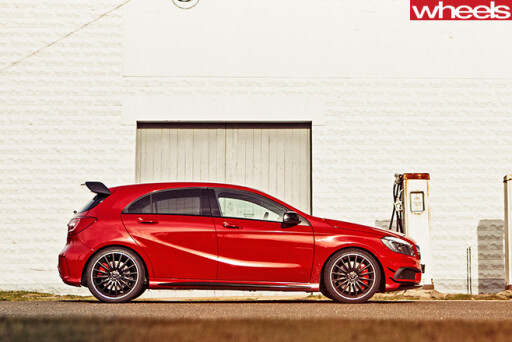 IN 2013, the hot hatch not only reached puberty, it grew biceps the size of Popeye’s and had its nipples pierced. All thanks to the A45 AMG – surely the most unlikely Mercedes-Benz product of all time. And one of its best.
IN 2013, the hot hatch not only reached puberty, it grew biceps the size of Popeye’s and had its nipples pierced. All thanks to the A45 AMG – surely the most unlikely Mercedes-Benz product of all time. And one of its best.
Long gone are the days when you could rely on an AMG to nail the straights, but not necessarily the corners. The A45 can do both. Thanks to a bratty sports exhaust system that is standard on all Aussie cars, and a launch-control function that fulfils every WRC fantasy, the A45 ignites from a standing start in a fashion Subaru STis and Mitsubishi Evos could only dream of. Four-point-four seconds later, you’re doing 100km/h; the 400m mark flashes by in 12.6sec. And here we were thinking a hot-hatch is quick if it can sneak into the 13s…
Equally as thrilling, though, is the A45’s cornering ability. Looking at its on-paper stats, you’d think a best-case torque split of 50/50 wouldn’t be enough to engender excitement, let alone handling poise, yet the A45 strings it all together like finely woven fabric, especially when being thrown from one direction to another, transferring weight onto its outside rear tyre for laughably thrusty corner exits.
Only on a fast racetrack like Phillip Island does the A45’s dynamic repertoire introduce understeer, though if track days are your thing, tick the $1990 sports suspension box. With 20 percent stiffer springs, front-end push is dissolved and the A45’s poise becomes sublime. Don’t know about its country-road ride though…
That said, like just about every RS-badged Audi, the A45 often rides better than its lesser brethren. It’s definitely no magic carpet, but compared to an 18-inch-wheeled A-Class on sports suspension, the stock A45 is almost comfortable. Likewise its terrific sports front seats with electric bolsters, its flat-bottomed, Alcantara-clad steering wheel, and that blurting, braaping sound from its exhaust. Downshift and back off simultaneously, or short-shift under a steady throttle load and you can actually play tunes with it.
What the A45 isn’t is an older person’s car. It’s even less attuned towards urban comfort than the C63, yet it’s an entirely liveable superhot-hatch if firmly suspended cars are your thing. And at $74,990, it’s a relative bargain.
Think about that for a minute – a top-spec Evo for $66K or an A45 for $75K? In our opinion, no contest. That’s also the reason why we haven’t compared the A45 against a BMW M135i – the AMG would smash it. All hail the new hot-hatch king. – Nathan Ponchard
Four’s kin
IF YOU think Mercedes-Benz has never done a high-performance four-cylinder, you’d be wrong. At the Frankfurt show in September ’83, Mercedes launched the 190E 2.3-16 – a W201 sedan running a 138kW twin-cam, 16-valve 2.3-litre four developed by Cosworth. In its final incarnation – the 2.5-16 Evolution II (1990) – the hot 190E punched out 172kW at 7200rpm and had a rear wing larger than Concorde’s.
Ferrari F12 Berlinetta
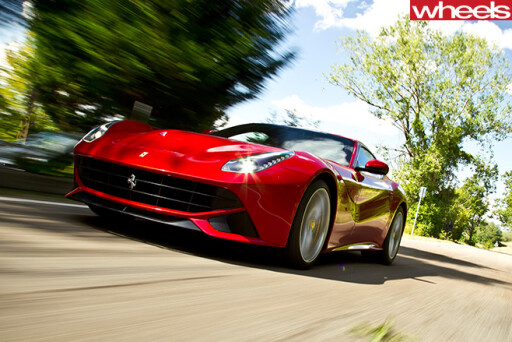 Don’t BE surprised to see the F12 here. We know it’s not exactly a real-world selection, but when the F12 sits at the peak of my list of Best Cars Ever, the $691K Ferrari simply can’t be ignored. Not just because the F12 is the fastest Ferrari road car of all time – in outright acceleration and around Maranello’s famed Fiorano test track (at least until we test LaFerrari, the 708kW hybrid) – more that, despite being dominated by the staggering power of its normally-aspirated 6.3-litre V12, the F12 is only intimidating if you consciously set out to access all 545kW and 690Nm.
Don’t BE surprised to see the F12 here. We know it’s not exactly a real-world selection, but when the F12 sits at the peak of my list of Best Cars Ever, the $691K Ferrari simply can’t be ignored. Not just because the F12 is the fastest Ferrari road car of all time – in outright acceleration and around Maranello’s famed Fiorano test track (at least until we test LaFerrari, the 708kW hybrid) – more that, despite being dominated by the staggering power of its normally-aspirated 6.3-litre V12, the F12 is only intimidating if you consciously set out to access all 545kW and 690Nm.
Ferrari has thoroughly re-engineered the now direct-injection V12, now surely the best performance engine in the world, to reduce friction, increased the compression ratio to 13.5:1 and by employing all kinds of clever technology to help increase low-end torque. The result is an engine that revs to 8700rpm, yet provides 80 percent (or 552Nm) of peak torque from only 2500rpm. Incredibly tractable and responsive as well as rev happy, you quickly discover that there is no need to be constantly changing gears via the paddles that operate the brilliant dual-clutch gearbox.
To benefit traction, F12’s transaxle and a V12 that’s almost all behind the front-axle line, produce a 46/54 weight distribution. Yet, such is the F12’s power that its steady-state understeer can easily be pushed through by flexing your right foot.
So transparent and accessible is the car’s balance that you adjust the cornering attitude and balance on the throttle, exiting turns in power oversteer. Save this hooliganism for track days, knowing that the literally tyre-shredding performance demands concentration at the limit, but also that heroic point-to-point times are possible without fear, so trustworthy is the handling (if you avoid tapping too far into the ferocious performance).
Light and super-quick steering, just 2.0 turns lock-to-lock, disguises the respectable 1630kg bulk to make the car feel agile, while turn-in is instantaneous, more thought process than deliberate movement of the wheel. The ride, too, is exactly right in matching the conditions or the driver’s mood. Electromagnetic dampers allow a choice between soft and firm settings that is independent of the stability-control system and the electronic differential and traction control.
The F12’s pace is epic, barely believable. As is the refinement, drivetrain flexibility and ride quality. No car currently made delivers exhilaration and sophistication as effectively as the Ferrari F12. – Peter Robinson
One big Bull, gelded
LAST YEAR in Italy, John Carey and I concluded that the F12 comprehensively demolished the equivalent Lamborghini in an on-the-road shoot-out. In dynamic terms the F12 simply destroyed the Aventador. Ferrari was unhappy that we compared the F12, until chairman Luca Montezemolo held up the comparo as one of the year’s highlights at the annual dealer conference.
Toyota 86/Subaru BRZ
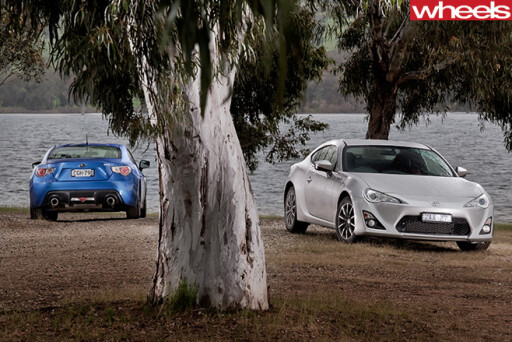 EIGHTEEN months on from launch, and our 2012 Car Of The Year-winning 86/BRZ twins still provide the definitive affordable sports car experience. Even in an era defined by interesting coupes and piping-hot hatches, the Toybaru remains as much a value juggernaut as a driver’s dream.
EIGHTEEN months on from launch, and our 2012 Car Of The Year-winning 86/BRZ twins still provide the definitive affordable sports car experience. Even in an era defined by interesting coupes and piping-hot hatches, the Toybaru remains as much a value juggernaut as a driver’s dream.
That the base price hasn’t budged since June last year when Toyota dropped the 86 GT’s $29,990 bombshell is as remarkable as the car itself. To the company’s credit, only the (unexpectedly effective) GT auto’s RRP has crept up – though the $300 hike now brings the Torsen limited-slip differential previously denied to that particular model.
The 86/BRZ just keeps getting better with age. And its appeal is timeless – a tantalisingly small and lightweight rear-driver with not an ounce of extraneous flab, contained within an unashamedly Japanese old-school cab-backward coupe silhouette of classic proportions.
In the name of weight saving (and cost), a 147kW/205Nm 2.0-litre direct-injection, naturally aspirated flat four set well behind the front axle provides sufficient low-speed tractability and surprisingly effective mid-range punch.
Okay, clearly some of you out there would prefer more low-down oomph, but the whole point of the 86/BRZ is its measured balance. Toyota and Subaru’s engineers collaboratively sweated over the driver’s relationship with the telepathically tactile steering, sweet six-speed manual gearbox, progressively weighted clutch, and brutally effective brakes, which all somehow gel together with cohesion not expected this side of a Porsche Cayman.
Even on the basic 86’s eco-rated ‘Prius’ tyres, this car handles with laser-guided precision, acrobatic balance, and outstanding control. Just be prepared to catch that rear with the electronic safety-net removed in the wet. Regardless, though, this is life-affirming stuff. Beyond Blue ought to give ’em away.
Finally, there’s the little coupe’s packaging. Sure, in this premium-obsessed world of soft-touch surfaces and fancy fittings, the 86/BRZ’s cabin looks, feels, and sounds more like a late-80s Celica throwback than, say, an Audi T. But the sense of occasion is certainly present. The driving position is simply perfection, the available space ample for two adults, and the very occasional rear-seat folds forward to provide a boot big enough to take a bicycle.
For sheer sports-car fun, then, there remains no peer. Can you think of a more focused rear-drive coupe under $100K, let alone $40K? – Byron Mathioudakis
To helmet and back
ACCORDING to chief engineer Tetsuya Tada, the 86/BRZ’s front headrests are designed to accommodate a driver wearing a helmet; you simply pull it off and then refit facing backwards.
He also had a 1967 Toyota 2000GT placed in the design studio alongside a clay model, to make sure the designers didn’t get the proportions wrong.
Priorities, priorities…
Porsche Cayman
 No car is perfect. If perfection were possible, Porsche engineers would be throwing themselves off buildings, en masse, which would make the world a less wonderful place.
No car is perfect. If perfection were possible, Porsche engineers would be throwing themselves off buildings, en masse, which would make the world a less wonderful place.
The desire these obsessive-compulsive Germans have to get as close as possible to perfect with a new car, build it, release it, and then start work immediately on making it even better is a thing to behold, and admire.
And yet the stories coming out of the launch of the latest Porsche Cayman might have led you to believe that progress had finally peaked; that this Cayman is the ultimate expression of what a sports car can be. Indeed, Bill McKinnon, a highly respected road tester, went as far as giving this car a perfect 10 out of 10 score in another publication.
The last Cayman was, of course, pretty bloody good, but this new one is a staggering 40 percent more torsionally stiff, and is also 30kg lighter. Its track is wider, its styling is more manly and, obviously, it’s faster than ever.
Peter Robinson will tell you that its steering is not as good as it should be, thanks to the introduction of a silly, fuel-saving electric system, and it’s true that the last one was more fantastic in that department. But in every other way, this car is a big step up.
The fact is, perfect is the word that comes to mind when you drive the Cayman around a corner. There is a moment, particularly in changing direction between two bends, when the entry-level, bargain-basement Porsche seems to pivot around you, seemingly at a point just beneath your left butt cheek, and you feel a kind of mechanical purity, a moment of real magic, as the car hooks up through your hands, the g-forces push on you and everything feels just right.
There are few cars that can deliver that moment and the mid-engined balance of the Cayman makes it, in some few ways at least, even more magical than the big brother – and admittedly more exciting overall – 911.
Throw in a manual gearbox that’s better than any other car currently in production, a brilliant dual-clutch option, brakes that offer both feel and force, and you’ve got one hell of a package.
Only the price really costs the Cayman when it comes to giving it a perfect score. At $107K, it’s less than it has been before, but still feels like more than it should be, particularly compared to what people buy them for overseas.
What is truly incredible, of course, and truly wonderful, is that right now, a team of people in Germany are working to make the next one even better. Bring it on. – Stephen Corby
That’s a bit tough
I ONCE asked a Porsche engineer if it was true that every part of their cars is over-engineered by 300 percent. He looked at me horrified. “Oh no, absolutely not; it would be more than that.”
Volkswagen Up
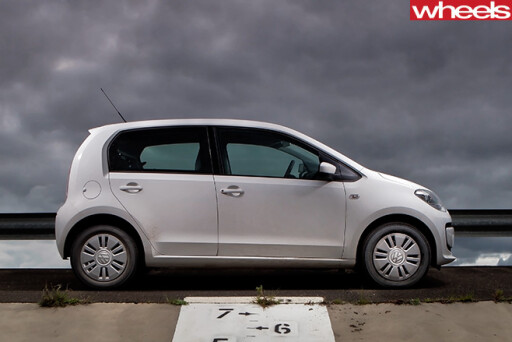 VOLKSWAGEN’S diminutive, distinctly undersold Up goes beyond being just a scaled-down Golf – though there are striking similarities there, too.
VOLKSWAGEN’S diminutive, distinctly undersold Up goes beyond being just a scaled-down Golf – though there are striking similarities there, too.
As the first of a line that its maker intends to someday become the brand’s global best-seller, the Up pioneers the same level of groundbreaking flair in its under-$15K sub-light-car segment that the first Golf brought to the Datsun 120Y class way back when.
Let’s begin with the dinky ’Dub’s packaging brilliance. Imagine a Polo with about a Subway Footlong’s worth of overhang chopped from each end, while still retaining the same interior length. VW basically miniaturised the mechanicals. Tiny engine. Smaller ancillaries.
Only the tracks are narrower, but that’s perfect for a city car. So four adults fit in fine, sitting comfortably on firm seats, backed up by a sterling driving position.
Whether you’re in the driver’s seat or just in for the ride, no rival can match the Slovakian-built runabout’s disarming refinement. Its quality ambience is certainly no Mirage.
Mind you, all is not perfect inside, with pitiful face-level ventilation, feeble air conditioning on hotter days, and vision-obstructing A-pillars.
The boot is also fairly bijou at 241 litres, although Up’s boxy proportions mean the available 951 litres with rear backrests downis actually very useable.
Meanwhile a super-frugal 55kW/95Nm 1.0-litre triple makes light work of hauling the sub-900kg VW around, aided by a slick five-speed manual shifter, a big wad of low-down torque, a revvy disposition, and a rorty exhaust.
Better still – and here’s where the Golf connection tees off big time – is the Up’s class-redefining dynamic capabilities. Crisp electric power steering that feels tight, sharp and reactive around town is one thing, but tenacious high-speed grip and fabulous body control on skinny 165/70R14 rubber is quite another. Throw in subtle traction-intervention tuning, strong brakes and a supple ride, and the invigorating Up makes you feel alive.
What we’re saying, folks, is that the classless Volkswagen Up transcends its now more-affordable $14K driveaway pricing with breathtaking insouciance.
Friendly, accessible, safe and fun, it’s the modern VW masterpiece most Aussies inexplicably ignore – perhaps due to the lack of an automatic transmission option.
Even then, the manual-only Up is still our automatic baby of choice, hands down. – Byron Mathioudakis
What’s Up with that?
ALONG with the three- and five-door hatchbacks already here, a cornucopia of Up-based spin-offs are planned, from a turbo GT to the fully-fledged Taigun to take on the new Fiat Panda Trekking. But none are likely for Oz, as all are too small for Australian tastes, according to VW.
Ford Fiesta ST
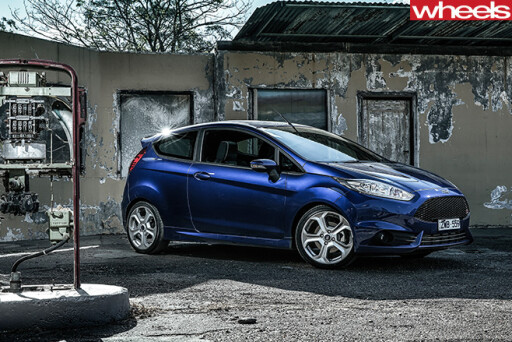 HOW OFTEN have you been genuinely surprised this year? I know one colleague who swore on all the fingers on his hands that there was no way the people of Australia would vote Tony Abbott in. I bet he’s finding it difficult to type by now.
HOW OFTEN have you been genuinely surprised this year? I know one colleague who swore on all the fingers on his hands that there was no way the people of Australia would vote Tony Abbott in. I bet he’s finding it difficult to type by now.
It’s hardly surprising that the Porsche Cayman is a wonderful car. Indeed, you kind of expect it. It’s a similar thing with HSV’s GTS – the fact that it has 430kW to play with means it’s no surprise when you find yourself grunting with manly delight.
But Ford’s Fiesta ST really, truly surprised me. On paper, it was offering just 134kW and 240Nm from a 1.6-litre turbo engine, but by the time we got to drive it, reams of paper had also been used by overseas magazines to laud it as some kind of giant-killing mighty mouse.
Peugeot has had the misfortune of launching its extremely important 208 GTi at the same time as the Fiesta has landed, and it was after enjoying an excellent Putty Road blast in the solidly impressive Pug that I first stepped into the feisty Ford.
To be fair, I wasn’t really surprised. I was gobsmacked. Figures can’t do a car like this justice. A 0-100km/h time of 7.0 seconds does not make a prima facie case for excitement. Indeed, the 208 GTi was almost half a second quicker, but there’s just something about the way this hot hatch delivers its middling power that takes it to another level.
Sliding into proper Recaro seats gives an instant impression of sportiness, but it’s the way the steering talks to you, the way the taut, pert little chassis rockets, rock-solid, through the bends, the way the engine screams willingly all the way to the 6000rpm redline that delivers so richly on that promise.
Ford has discovered how to make its electric power steering feel as fabulous as any of the best hydraulic systems of old. Indeed, a comparison with Porsche/Toyota 86 steering is not out of place. The seating position might not be as good – you’re a little too high for my liking – but the kind of focus on fun and driver involvement is something shared by all three.
Yes, it does feel a bit cheap inside, but it’s a car based on a budget platform, taken to another level entirely. And the fact is, it is cheap – for what it offers, it’s an absolute bargain at $25,990.
If there’s a cheaper way to deliver surprise and delight, again and again, then it simply can’t be found in a car. Bang-for-your-buck wise, I’d go so far as saying the Fiesta ST is the best value sports car on the planet. – Stephen Corby
Sipped at the post
NOT ONLY do you save buckets of money by buying a Fiesta ST over, say, a similarly enjoyable Mercedes-Benz A45, you’re also saving on fuel, and thus saving the world. Driven hard – because it was so much fun to do so – the Fiesta still managed to deliver an economy figure of 10.5L/100km on our test. I’ll say it again – this car is a bargain.
Volkswagen Golf GTI
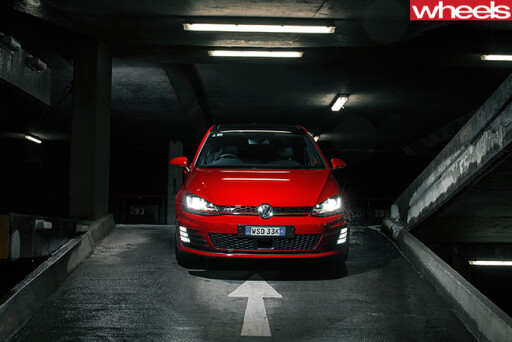 Designing a car for a single purpose is relatively easy. With a sharp, specific focus, whether that’s the ability to go around corners fast, or climb rocks, or carry eight people, few compromises are involved in the layout or packaging, which is basically defined by the vehicle’s intended function.
Designing a car for a single purpose is relatively easy. With a sharp, specific focus, whether that’s the ability to go around corners fast, or climb rocks, or carry eight people, few compromises are involved in the layout or packaging, which is basically defined by the vehicle’s intended function.
Creating a car to do everything – well, almost everything – is impossible because some attributes are mutually incompatible, even if a Range Rover tries hard to prove me wrong. The greatest car, then, is the all-rounder, a jack-of-all-trades and master of none.
Behold the Volkswagen Golf GTI. Fast and frugal, practical, beautifully finished, well equipped and dynamically appealing, the latest GTI adds a welcome touch of real-world comfort to the equation. If I had to choose just one car to last for the next decade, this would most probably be it. Play sports car, via the superb 162kW third-generation EA888 engine, and the GTI combines fun with real performance. Its 0-400m time of 14.5 seconds is a match for any rival at remotely the same price, while the efficiency (6.2L/100km combined-cycle economy for the manual) is remarkable. A new level of chassis composure and effortless manners is also laid upon VW’s best car.
The interior oozes quality and feels as if it belongs to a German car of twice the price. If you don’t believe me, shut the door: the solid thunk defines the engineering integrity that characterizes Golf VII (and VW’s new MQB architecture). That refinement, the supple, yet controlling suspension (courtesy of adaptive damping that really works), brilliant seats
and a high-quality steering wheel ensure the GTI feels expensive from behind the wheel. The now-variable-ratio steering is super quick – 2.1 turns combined with a tight 10.9-metre turning circle – and transfers information without the intrusion of nasty torque steer. If I’m super critical, feel is vaguely artificial but the steering remains one of the best electric systems and a massive step over the old car.
We love the Golf GTI because, even with the raft of enhancements that elevate it to new levels of performance and finesse, at heart it remains a GTI. The GTI’s giant-killer role, achieved with utterly civilised composure, confirms this VW as all the car you’ll ever need. No wonder the GTI is expected to takes 20 percent of all Golf sales in Australia next year. – PR
Rubbery figures
WE OWE you an apology. Understandably, we accepted VW Australia’s official press kit as definitive in compiling the GTI’s specifications (Wheels, November). Wrong. Instead of an overall length of 4349mm, the correct figure is 4268mm. Likewise the wheelbase (quoted as 2620mm) should be 2631mm, and height is 1442mm, not 1491mm. To be fair, we should also acknowledge that launch control is indeed a feature of the DSG gearbox.

COMMENTS